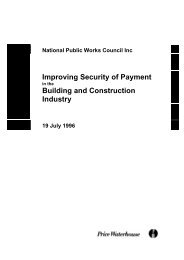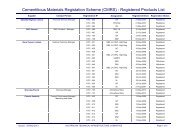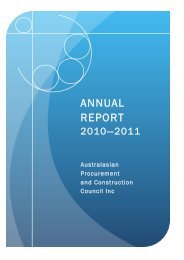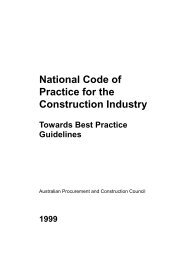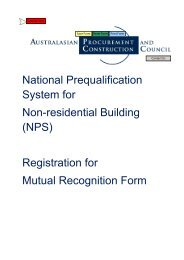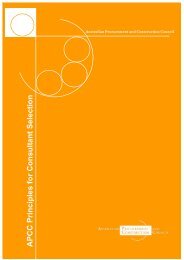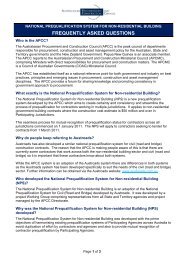APCC PUB_ANZ Government Framework for Sustainable ...
APCC PUB_ANZ Government Framework for Sustainable ...
APCC PUB_ANZ Government Framework for Sustainable ...
Create successful ePaper yourself
Turn your PDF publications into a flip-book with our unique Google optimized e-Paper software.
ForewordAcross the world large organisations have been seeking sustainable outcomesthrough their procurement. By incorporating sustainability principles and practices,procurement has the potential to reduce negative outcomes <strong>for</strong> society and the naturalenvironment.The United Nations and the Organisation <strong>for</strong> Economic Cooperation andDevelopment (OECD) have promoted sustainable public procurement. Manygovernments, industry sectors and corporations have produced policy statements,supplier codes of conduct and product specifications to address sustainability inprocurement activities.Many governments have already made a commitment to sustainable procurement aspart of broader environmental and social policy agendas. Just as the rest of the worldAUSTRALIAN PROCUREMENT AND CONSTRUCTION COUNCILis making ef<strong>for</strong>ts in these areas, there is heightened interest in sustainability inAustralia and New Zealand. It is an opportune moment to establish a nationalapproach to sustainable procurement.In May 2006, the Australian Procurement and Construction Council (<strong>APCC</strong>)established a working group to develop an Australian and New Zealand <strong>Government</strong><strong>Framework</strong> <strong>for</strong> <strong>Sustainable</strong> Procurement (the <strong>Framework</strong>). The <strong>Framework</strong> delivers anagreed national and trans-Tasman approach to integrating sustainable developmentconsiderations in Australian and New Zealand public procurement.The purpose of this <strong>Framework</strong> is to provide a set of national principles to assist thegovernments of State, Territory and Commonwealth jurisdictions and New Zealand tointegrate the principles of sustainability into the procurement of goods, services andconstruction.Jurisdictions will be able to customise the <strong>Framework</strong> to suit their purchasingenvironment and reflect the principles in the <strong>for</strong>m of policies, guidance material,training and tools <strong>for</strong> use by practitioners.The <strong>Framework</strong> is built on the premise that sustainable procurement balanceseconomic, environmental and social considerations in the procurement process.It supports and encourages collaboration between government jurisdictions to developnational programmes and tools to promote the principles of sustainable procurementand to share experiences, given that sustainability issues are not constrained byjurisdictional borders.Leadership by governments can provide the necessary incentive <strong>for</strong> business to adoptinnovation and sustainable practices which benefit us all.The Honourable Robert Schwarten MPChairAustralian Procurement and Construction Ministerial Council2
ForewordThe New Zealand government has welcomed the opportunity to collaborate with theAustralian Commonwealth, state and territory governments in developing this joint<strong>Framework</strong> <strong>for</strong> <strong>Sustainable</strong> Procurement.We recognise the importance of taking the lead in tackling issues of sustainability.Accordingly, the New Zealand government is working to ensure that sustainabilityissues are taken into account in decision-making processes.Good procurement practice serves efficient and cost-effective government. But it isclear that government procurement also has great potential to contribute to broadereconomic, environmental and social objectives. For example, through sustainableprocurement, we can drive the production of environmentally-friendly goodsand services. This has the potential to deliver the initial step change and ongoingmomentum required to ensure that we gain the benefits that will accrue to those whomeet the challenges of climate change.The joint <strong>Framework</strong> <strong>for</strong> <strong>Sustainable</strong> Procurement will help ensure that Australia andNew Zealand can work together effectively to meet these future challenges headon. It will do this by providing consistency across government and by guiding theimplementation of cost-effective initiatives that relate to sustainable procurement. Thesustainability imperative means that we must emphasise the economic, environmentaland social impacts of goods and services over their entire lifecycle as part of thevalue-<strong>for</strong>-money assessment.The joint <strong>Framework</strong> is written in the spirit of the <strong>ANZ</strong> <strong>Government</strong> ProcurementAgreement, the fundamental principle of which is that all <strong>ANZ</strong> suppliers have equalopportunity to compete in our government markets on the basis of value <strong>for</strong> moneyover whole of life.This <strong>Framework</strong> provides yet another step towards the sustainable development goalsgovernments in both Australia and New Zealand are committed to achieving.Hon. Lianne Dalziel Minister of Commerce The New Zealand <strong>Government</strong>AUSTRALIAN PROCUREMENT AND CONSTRUCTION COUNCIL3
Introduction<strong>Government</strong> procurement may be described as purchases made by public sectororganisations in delivering their core activities to serve the community. <strong>Government</strong>procurement markets are significant within OECD countries, being estimated toaccount <strong>for</strong> 10% to 15% of gross domestic product (GDP). Australian State, Territoryand Federal governments spend approximately A$100 billion per annum on goods,services and construction, and the New Zealand <strong>Government</strong>’s spend is estimated tobe in the range of NZ$14 to $20 billion. This expenditure presents a considerableopportunity to achieve direct sustainable development benefits.<strong>Sustainable</strong> procurement can minimise the environmental impacts of public sectororganisations, as well as benefiting society, the natural environment and reducingoverall operating costs.AUSTRALIAN PROCUREMENT AND CONSTRUCTION COUNCILGlobally, there is a concerted ef<strong>for</strong>t to achieve sustainable procurement outcomes.The United Nations and OECD have been promoting sustainable procurement <strong>for</strong>many years. The UK, USA, Canadian and Japanese governments have sustainableprocurement policies (or legislation) with extensive implementation programs.The Australian Procurement and Construction Council (<strong>APCC</strong>) has developed thisAustralian and New Zealand <strong>Government</strong> <strong>Framework</strong> <strong>for</strong> <strong>Sustainable</strong> Procurement(<strong>Framework</strong>) as a set of national and trans-Tasman principles to guide AustralianState, Territory and Federal governments and the New Zealand <strong>Government</strong> inimplementing sustainable procurement.4
<strong>Sustainable</strong> development and procurement<strong>Sustainable</strong> development is ‘development that meets the needs of the present withoutcompromising the ability of future generations to meet their own needs.’ 1<strong>Sustainable</strong> procurement has been defined by the United Kingdom <strong>Government</strong>commissioned<strong>Sustainable</strong> Procurement Task<strong>for</strong>ce as “…a process wherebyorganisations meet their needs <strong>for</strong> goods, works and utilities in a way that achievesvalue <strong>for</strong> money on a whole life basis in terms of generating benefits not only to theorganisation, but also to society and the economy, whilst minimising damage to theenvironment.” (Procuring the Future, <strong>Sustainable</strong> Procurement Task Force, 2006) 2<strong>Sustainable</strong> procurement considers products and suppliers. This includes issues suchas: resource extraction and consumption; manufacturing and production; transportand logistics; product and asset design; use and maintenance; recycling and disposaloptions; employee rights and conditions, corruption, unfair competition and ethicalbehaviour.<strong>Sustainable</strong> procurement means that when buying goods and services organisationspracticing sustainable procurement will consider:• strategies to avoid unnecessary consumption and manage demand;• minimising environmental impacts of the goods and services over the whole oflife of the goods and services;• suppliers’ socially responsible practices including compliance with legislativeobligations to employees; and• value <strong>for</strong> money over the whole-of-life of the goods and services, rather than justinitial cost.The set of principles described in this <strong>Framework</strong> should be integrated into business asusual procurement practice.AUSTRALIAN PROCUREMENT AND CONSTRUCTION COUNCIL1 WCED, Our Common Future 19872 The Task Force was business-led composed of 33 members representing leading supply chain practitioners,suppliers to the public sector and their trade associations and all levels of government.5
The benefits of sustainable procurementThe public sector, business, industry, Australians and New Zealanders have muchto gain from the implementation of sustainable procurement practices by theirgovernments. Some of the benefits of sustainable procurement which have beenidentified include:1.Reduces adverse environmental impacts arising from <strong>Government</strong> procurementaction.• Reduces waste to landfill, saves water, reduces greenhouse gas emissions,decreases air and water pollution, saves money through re-using materialsand products, and reduces consumption of both natural and processedresources.• Ensures the health and safety of the community.AUSTRALIAN PROCUREMENT AND CONSTRUCTION COUNCIL2.3.4.Makes more efficient use of public resources.• Reduces costs through greater energy efficiency, reduced waste disposal, andreduced risk management.• Lowers the cost <strong>for</strong> products over their life cycle.Stimulates the local and global markets to innovate and produce moresustainable products and services <strong>for</strong> public and private organisationalpurchasers, and Australian and New Zealand consumers.• Increases the availability of environmentally preferred products and servicesat cost-effective prices; expands the market <strong>for</strong> environmental products andservices with potential <strong>for</strong> local businesses.• Improves the level of in<strong>for</strong>mation available to buyers about the content andper<strong>for</strong>mance of products, facilitating the choice to purchase environmentallypreferred products.Demonstrates that Australian and New Zealand governments are committed toachieving sustainable development objectives.• Provides government leadership to the community in demonstrating socialand environmental responsibility through the purchase of environmentallypreferred products and services.• Reduces the potential negative publicity associated with the purchase anduse of products, services and suppliers with poor environmental and socialresponsibility records.6
Implementing the Australian and New Zealand<strong>Government</strong> <strong>Sustainable</strong> Procurement <strong>Framework</strong>Leadership and GovernanceIn order to implement the Australian and New Zealand <strong>Government</strong> <strong>Sustainable</strong>Procurement <strong>Framework</strong>, it is important to consider the governance elements, whichwill facilitate implementation in public sector organisations. These include strong andsupportive leadership together with the following organisational processes:Organisational Integration• Ensure that sustainable procurement is reflected in organisational goals, policiesand management per<strong>for</strong>mance indicators.• Promote awareness of sustainable procurement throughout the organisation.• Ensure that staff has the appropriate skills, knowledge and access to in<strong>for</strong>mationsources to apply the principles and practices of sustainable procurement.• Support the provision of, and access to, training programs that improve the levelof staff awareness about sustainable procurement.• Consider the establishment of a core of expertise to assist and advise organisationson sustainable procurement processes and practices.• Review the operational arrangements within organisations that create a barrier tothe adoption of sustainable procurement.• Consider the implementation of environmental management systems that drivesustainable procurement and reduce consumption.Policy and Process Development• Develop policies that consider sustainability factors in all stages of procurement.• Provide practical guidance and tools to assist practitioners in the delivery ofprocurement outcomes that satisfy sustainability objectives.• Ensure that any related procurement programs and processes involving measuresto develop Australian and New Zealand SMEs, strategic sourcing and marketengagement consider incorporating sustainability objectives in their developmentand application where applicable.• Ensure that government procurement complies with obligations underinternational agreements.AUSTRALIAN PROCUREMENT AND CONSTRUCTION COUNCILMonitoring and Reporting• Establish monitoring and reporting systems against sustainable procurementtargets to demonstrate progress.• Consider sustainable procurement reporting into annual per<strong>for</strong>mance reports.7
Principles that guide the implementation ofsustainable procurementThese principles can be used to guide public sector organisations to developsustainable procurement strategies, policies, guidance material, training and tools.The four principles of the <strong>Framework</strong> are:1.2.3.Adopt strategies to avoid unnecessary consumption and manage demand;In the context of whole-of-life value <strong>for</strong> money, select products and serviceswhich have lower environmental impacts across their life cycle compared withcompeting products and services;Foster a viable Australian and New Zealand market <strong>for</strong> sustainable productsand services by supporting businesses and industry groups that demonstrateinnovation in sustainability; andAUSTRALIAN PROCUREMENT AND CONSTRUCTION COUNCIL4.Support suppliers to government who are socially responsible and adopt ethicalpractices.These principles are further explored below. They are illustrated by examples of bestpractice implementation activities.The <strong>Framework</strong> also supports and encourages collaboration between the jurisdictionsto develop national programs and tools to promulgate the principles of sustainableprocurement and to share experiences.A further aim of the <strong>Framework</strong> is to encourage wider adoption of sustainableprocurement through partnerships between governments, organisations, industry,business, education centres and the not-<strong>for</strong>-profit sector.The four guiding principles are supported by best practice implementation activitieswhich agencies can use to develop sustainable procurement strategies, policies,guidance material, training and tools.8
Principle OneAdopt strategies to avoid unnecessary consumption andmanage demand.Implementation activities include:• Assess the need <strong>for</strong> a given purchase and, whenever possible,reduce consumption through demand management initiatives.• Consider the alternatives to purchasing the product: reuse,refurbish or recondition the product or its components to extendits life.• Consider acquiring second-hand or used items.• Consider alternatives to acquisition, such as introducing serviceoptions to meet a need.• Consider the on-going service requirements of any product to bepurchased.• Investigate the possibility of aggregating demand amongstmultiple users, to achieve better usage of assets.• Consider the establishment of management systems to monitorand report consumption levels.• Adopt flexible work practices and service arrangements that takeinto account energy and resource efficiencies that balance outpeak environmental demand situations.• Collaborate with service providers to reduce consumption andimplement demand management strategies.AUSTRALIAN PROCUREMENT AND CONSTRUCTION COUNCIL9
Principle TwoIn the context of whole-of-life value <strong>for</strong> money, select productsand services which have lower environmental impacts acrosstheir life cycle compared with competing products andservices.Implementation activities include:• Adopt a life-cycle (or total cost of ownership or whole-of-life)costing approach to quantify the ‘total cost’ of procuring productsincluding operational per<strong>for</strong>mance, as opposed to only takinginto account the initial cost.• Ensure that decisions on sustainable values of products andservices are evidence based.AUSTRALIAN PROCUREMENT AND CONSTRUCTION COUNCIL• With all factors being equal in the purchase of a product, choosea product with the least environmental impact.• Use of Australian Standards and New Zealand or InternationalStandards Organisation (ISO) standards (where appropriate) toverify the sustainability credentials of a supplier and a product.• Consider the environmental management practices of thesupplier/manufacturer. Refer to benchmarking environmentalmanagement programs where practicable, such as Enviro-MarkNZ and ISO 14001.• Refer to eco-labelling programs and government labellingprograms to assist in assessing the environmental per<strong>for</strong>manceof products (Energy Star, Energy Rating Label, Water EfficiencyLabelling Scheme, Environmental Choice New Zealand).• Give preference to products that are reusable, recyclable and/or contain recycled content where such products fit the purpose,provide environmental benefits and are of comparable cost andquality to alternative products.10
Principle ThreeFoster a viable Australian and New Zealand market <strong>for</strong>sustainable products and services by supporting businesses andindustry groups that demonstrate innovation in sustainability.Implementation activities include:Environmental Stewardship• Adopt approaches to product design, production andmanufacturing that include a whole-of-life assessment.• Adopt a whole-of-life approach to building design, constructionand building operation that reduce environmental impacts, andwhere relevant apply environment and ecologically sustainabledesign principles.Encourage suppliers to:• Adopt design, manufacturing, production, distribution andservice processes that reduce the use of resources (energy, water)reduce greenhouse gas emissions; minimise the release of toxicsubstances; and minimise waste disposal to landfill.• Be responsible <strong>for</strong> end-of-life product impact through extendedproducer responsibility programs and take part in availablegovernment approved product stewardship schemes.• Become signatories to, and participants in, national commitmentsand government programs to improve environmentalsustainability; <strong>for</strong> example, the Australian National PackagingCovenant and the Australian Greenhouse Challenge, the NewZealand Packaging Accord and the New Zealand Waste Strategy.• Work together with their supply chain partners to adoptenvironmental management systems to track progress towardsenvironmental stewardship by reporting on the sustainability oftheir operation.AUSTRALIAN PROCUREMENT AND CONSTRUCTION COUNCIL11
Principle Three ContinuedMarket Development• Identify industry capability, particularly of Australian and NewZealand SMEs, in all major areas of procurement <strong>for</strong> sustainablegoods and services, consistent with the obligations under FreeTrade Agreements.• Establish specifications and procurement processes that do notrestrict innovation or disadvantage local suppliers of sustainablesolutions and encourage the commercialisation of environmentalinitiatives created under contract.• Support and stimulate long-term relationships with suppliers thatadopt sustainable practices.AUSTRALIAN PROCUREMENT AND CONSTRUCTION COUNCIL• Encourage a philosophy and practice of continuous improvementand innovation in sustainability by suppliers.• Collaborate with all spheres of government, industry and businessto stimulate a market <strong>for</strong> sustainable products and services.• Support initiatives that promulgate the awareness andprocurement of sustainable products and services.12
Principle FourSupport suppliers to government who are socially responsibleand adopt ethical practices.Implementation activities include:Require suppliers to:• Demonstrate a commitment to ethical behaviour and soundgovernance structures and processes.• Meet their employment obligations as required by relevantlegislation and other related instruments.• Consider relevant government employment policy objectivesthat relate to particular community sectors, including apprenticetraining, opportunities <strong>for</strong> disabled or injured workers returning towork, Aboriginal and Torres Strait Islander people, etc, consistentwith international obligations on government procurement.• Comply with applicable regulatory and legislative requirementsof occupation health and safety.AUSTRALIAN PROCUREMENT AND CONSTRUCTION COUNCIL13
GlossaryEnvironmentally Preferable ProcurementEnvironmentally preferable or ‘green’ procurement is defined “as the purchase ofproducts and services which have less impact on the environment and human healthcompared with competing products or services that serve the same purpose”.This comparison may consider the source of raw materials, production,manufacturing, packaging, distribution, potential <strong>for</strong> reuse and recycling, operation,maintenance, or disposal of the product”.US Environmental Protection Agency. (http://www.epa.gov/epp/pubs/about/about.htm)AUSTRALIAN PROCUREMENT AND CONSTRUCTION COUNCILGovt 3Govt 3 is a program <strong>for</strong> core New Zealand central agencies departments and Ministries.As of June 2006, 47 agencies had <strong>for</strong>mally signed up to Govt 3 membership. The Govt 3program also engages in less <strong>for</strong>mal partnerships with sustainability leaders in thewider public and private sectors.The Ministry <strong>for</strong> the Environment coordinates the Govt 3 program, offering assistance toagencies to undertake sustainable initiatives including providing in<strong>for</strong>mation, practicaltools, and links to other agencies that have undertaken similar initiatives. Govt 3focuses on four key topic areas: recycling/waste minimisation; buildings; transport;office consumables and equipment. (http://www.mfe.govt.nz/issues/sustainableindustry/govt3)Eco-LabelAn eco-label is a label which provides in<strong>for</strong>mation about the environmentalpreference of a product to consumers. In contrast to ‘green’ symbols or claimsdeveloped by manufacturers and service providers, an eco-label is awarded by animpartial third-party in relation to certain products or services that are independentlydetermined to meet environmental criteria. (The Global Ecolabelling Network).Eco-labels are designed to assist consumers to purchase those products that are lessharmful to the environment without spending too much time and ef<strong>for</strong>t in determiningwhich products are actually the least harmful.The New Zealand label is Environmental Choice NZ, operated under licence<strong>for</strong> the <strong>Government</strong> by the Ecolabelling Trust. It currently has approximately 30licence holding businesses in 20 product areas with over 700 products. (The GlobalEcolabelling Network http://www.enviro-choice.org.nz ).14
Energy Rating LabelA joint Australian and State/Territory government program which is recognisedas a key initiative to reduce greenhouse gas emissions. The mandatory labellingprogram allows consumers to make comparisons between appliances of their energyper<strong>for</strong>mance and there<strong>for</strong>e purchase more energy efficient appliances. It also providesan incentive <strong>for</strong> manufacturers to improve the energy per<strong>for</strong>mance of appliances.http://www.energyrating.gov.au/con3.htmlNew Zealand also requires certain products to be labelled as complying with theminimum energy per<strong>for</strong>mance standards (MEPS) <strong>for</strong> energy efficiency. See http://www.eeca.govt.nz/labelling-and-standards/meps.html . New Zealand works with Australiato keep MEPS levels the same, and almost are, or soon will be, joint standards withAustralia.Energy StarENERGY STAR is an international standard <strong>for</strong> energy efficient electronic equipment.It was created by the US Environmental Protection Agency in 1992, and has now beenadopted by several countries around the world, including Australia and New Zealand.Energy Star AustraliaThe Australian Federal, State and Territory <strong>Government</strong>s are cooperating through thenational ENERGY STAR program to encourage the use of energy efficient equipmentat home and in business. http://www.energystar.gov.au/about/index.htmlEnergy Star NZENERGY STAR is promoted in New Zealand by the Energy Efficiency andConservation Authority (EECA). The ENERGY STAR mark can now be found onleading heat lamps, dishwashers, washing machines, TV’s, DVD players, home theatresystems, computers and office equipment. See http://www.energystar.govt.nz/http://www.eeca.govt.nz/labelling-and-standards/energy-rating-labels.html.Water Efficiency Labelling Scheme (WELS)WELS is an Australian and New Zealand water efficiency labelling scheme thatrequires certain products to be registered and labelled with their water efficiency. Thescheme operates in accordance with the standard set under the Australian nationalWater Efficiency Labelling and Standards Act 2005 in Australia and in 2008 willoperate under the Fair Trading Act in New Zealand.http://www.waterrating.gov.au/about/index.htmlhttp://www.mfe.govt.nz/issues/water/wels-scheme.htmlAUSTRALIAN PROCUREMENT AND CONSTRUCTION COUNCIL15
National Packaging CovenantThe National Packaging Covenant has been the leading instrument <strong>for</strong> managingthe environmental impacts of consumer packaging in Australia since 1999. It is thevoluntary component of a co-regulatory arrangement based on the principles ofshared responsibility through product stewardship, between key stakeholders in thepackaging supply chain and all levels of Australian governments.http://www.deh.gov.au/settlements/waste/covenant/index.htmlPackaging Accord NZThe Packaging Council of New Zealand and the Ministry <strong>for</strong> the Environment havebrought together brand owners, retailers, importers, manufacturers, recyclers and localgovernment to negotiate a New Zealand Packaging Accord. The Accord was signedon 10 August 2004 and expires in 2009. Joint national targets include recovering aspecified percentage of the five main packaging materials - paper, plastic, aluminium,steel and glass - by weight of consumption. Recovery targets <strong>for</strong> 2008 are: 65% ofaluminium; 55% of glass; 70% of paper; 43% of steel and 23% of plastic.AUSTRALIAN PROCUREMENT AND CONSTRUCTION COUNCILGreenhouse ChallengeThe Greenhouse Challenge is an Australian Federal <strong>Government</strong> environment programintroduced in the mid-nineties, seeking to reduce greenhouse gas emissions throughthe voluntary action of companies and organisations.http://www.greenhouse.gov.au/challenge/index.htmlNew Zealand Business Council <strong>for</strong> <strong>Sustainable</strong> DevelopmentProvides business leadership and promotes eco-efficiency, innovationand responsible entrepreneurship. It aims include: business leadership;policy development; best practice advocacy and global outreach.It provides programs and support <strong>for</strong> business and policy makerson climate change, procurement, vehicles and transport, building,reporting, energy efficiency and waste. Its members tend to be largercorporates and some government agencies.http://www.nzbcsd.org.nz/<strong>Sustainable</strong> Business NetworkThe <strong>Sustainable</strong> Business Network is a <strong>for</strong>um <strong>for</strong> businesses that are interested insustainable development practices. It promotes sustainable practice in New Zealandand supports businesses on the path to becoming sustainable. It links businesses andprovides a <strong>for</strong>um <strong>for</strong> the exchange of ideas and experiences. The membership tendstowards smaller SMEs. http://www.sustainable.org.nz16
Extended Producer Responsibility (EPR)Extended Producer Responsibility (EPR) is a means to encourage producers toexamine the lifecycle of their products and to identify initiatives that will reduceresource use, reduce wastes at all points in a product’s whole lifecycle, reduce theenvironmental impacts of products and enhance post-consumer resource recovery.Hence, EPR places the responsibility primarily (but not exclusively) on the producersof the products of concern. http://wwwzerowastewa.com.au/documents/epr_ps.pdfProduct StewardshipProduct stewardship is a similar concept to EPR but the focus is on responsibility <strong>for</strong> aproduct’s impacts being shared more widely throughout the supply chain.http://www.mfe.govt.nz/issues/sustainable-industry/initiatives/product-stewardship/Design <strong>for</strong> the EnvironmentDesign <strong>for</strong> the Environment approach examines a product’s entire lifecycle andproposes changes to how the product is designed to minimise its environmentalimpact during its lifetime.http://www.deh.gov.au/settlements/industry/corporate/dfe.htmlISO 14001ISO14001 requires an Environmental Policy to be in existence within the organisation,fully supported by senior management, and outlining the policies of the company,not only to the staff but to the public. The policy needs to clarify compliance withenvironmental legislation that may affect the organisation and stress a commitmentto continuous improvement. A planned comprehensive periodic audit of theEnvironmental Management System is required to ensure that it is effective inoperation, is meeting specified goals, and the system continues to per<strong>for</strong>m inaccordance with relevant regulations and standards.Enviro-Mark NZEnviro-Mark is an Environmental Management System (EMS) originally developedin England and adapted <strong>for</strong> New Zealand use by Landcare Research as Enviro-MarkNZ. It is an internet- based tool to help businesses put in-house procedures in place,to meet health, safety and environmental standards, with five levels of certificationbased on the business’s size, activities, and any potential adverse impacts on theenvironment, by either the business itself or its suppliers. The process and the resultsare externally audited.http://www.landcareresearch.co.nz/services/sustainablesoc/enviromark/AUSTRALIAN PROCUREMENT AND CONSTRUCTION COUNCIL17
Australian Procurement and Construction CouncilUnit 6, 42 Geils Court, DEAKIN ACT 2600PO Box 106, DEAKIN WEST ACT 2600Phone: +61 02 6285 2255Fax: +61 02 6282 3787Email: info@apcc.gov.auWeb: www.apcc.gov.au



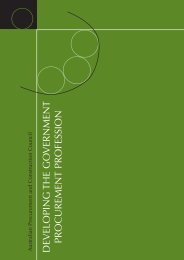
![NATIONAL COST ADJUSTMENT PROVISION EDITION 2 [NCAP2]](https://img.yumpu.com/48266135/1/184x260/national-cost-adjustment-provision-edition-2-ncap2.jpg?quality=85)
